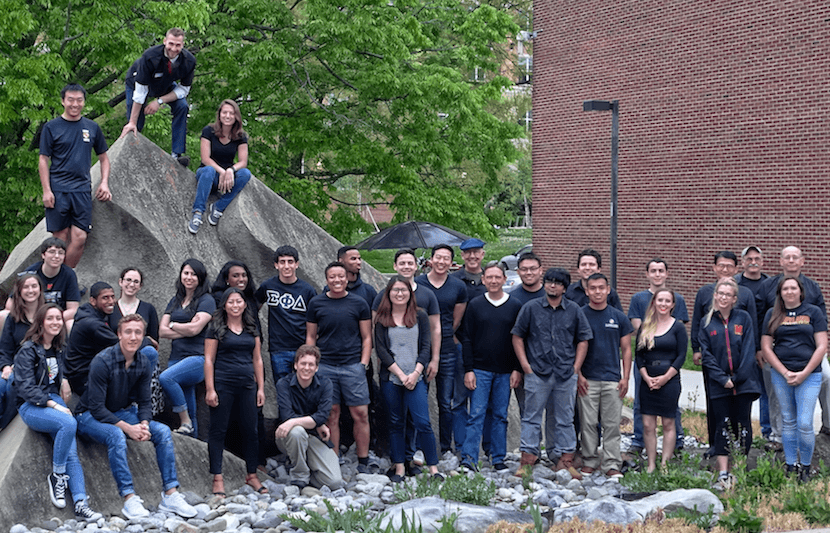A student team from the University of Maryland placed first in the U.S. and second in the world at the Solar Decathlon 2017, which is sponsored by the U.S. Department of Energy, for its entry of a prototype energy-efficient, solar-powered house, named resilient Adaptive Climate Technology (reACT).
The decathlon is an annual, international competition that challenges student teams from around the world to design and build full-size, solar-powered house. Competing teams are judged on 10 contests: architecture, market potential, engineering, communications, innovation, water, health and comfort, appliances, home life, and energy. Two of the contests — water and innovation — are new for this year’s decathlon. This is also the first year that the winning teams won cash prizes.
The UMD team, made up of students from various disciplines, took home $225,000 in winnings.
The team’s prototype house is designed as a “house as a kit of parts” with five modules centered around an interior courtyard, which operates as a spacious solar collector to preheat air and water.
The house also includes a paneled interior with living systems separate from its structure, allowing owners to adapt the house according to their unique and specific needs. Additionally, through systems that capture waste, water and energy, the house is able to function with complete self-sufficiency.
reACT’s many sustainable features include: a mechanical core to manage the flow of water, air and energy; a hydroponic garden; movable living walls; a barrel composter and composting toilet; a solar-powered washer and dryer; and rainwater and grey water collection and treatment systems.
“Water balance was an essential part of our net zero design; therefore, from the very beginning, we challenged ourselves to go beyond the use of grey water,” said Chris Cestello Hinojosa, assistant director of communications and external relations for the School of Architecture, Planning and Preservation. “Instead, we created a filtration system using inputs from rain water and dual-filtration systems that would designate two streams of filtered water: one to grey water standards (for washing and irrigation) and the other to potable standards (drinking water), an achievement heretofore not achieved.”
The new innovation contest also encouraged the team to focus on complete harmony with nature in its design.
“Integrated and holistic design solutions were sought in as many places as possible in order to construct a home in harmony with nature where nothing organic is wasted,” said Hinojosa.
“We based our design on the philosophy of Biophilia and regeneration; that is finding a use for the ‘waste’ product of one process that can serve as a resource for another.”
The team also made sure that innovation was married with market realities, as market potential was one of the contests. In this aspect, the team was inspired by the Nanticoke Indians.
“Native Americans are the only identifiable cultural/ethnic group that is clearly ecologically centered and proactive,” said Hinojosa.
The guiding principles behind reACT and the Nanticoke Indians are aligned, said Hinojosa.
“The [reACT] home’s design facilitates an ethical and culturally authentic Nanticoke life,” she said. “Despite its humble size, reACT enables families to create a home capable of evolving with its occupants, only using the footprint that is necessary at a given time in the life of a family. In addition, the reACT living systems’ attention to optimizing resources by limiting waste is aligned with the Nanticoke’s desire to reduce their negative impact on Mother Earth.”
reACT is rooted in the belief that a living space should be designed with the earth and future generations in mind, explained Hinojosa.
“Team Maryland views Mother Earth as a living, breathing being that should harmonize with the house,” she said. “reACT attends to Mother Earth’s breath (air) through our unique heating ventilation and cooling system (HVAC). We bring the Earth into the house by incorporating portable living green walls and outdoor living spaces. Our commitment to water protection is evident: each drop of water is accounted for and reused or recycled. The sun’s energy is directly harvested by reACT’s photovoltaic solar panels. The adaptive technologies developed through reACT are designed to improve our connection to local ecosystems. reACT recognizes that we as humans are intimately linked to all existence in an intricately designed web.”
reACT took two years — from the original concept drawings to the actual construction of the house — and cost around $300,000 to complete.
reACT will be back at UMD and “open for tours after it has a permanent foundation constructed and its ‘kit’ reassembled,” according to Patti Cossard, co-principal investigator for reACT’s entry into the decathlon and also UMD’s art librarian.
“The reACT Principal Investigators, Garth Rockcastle and Ray Adomaitis, are in discussions with University Administration and Facilities for the management of this phase of the project,” she continued. “Our target date for reACT to open early Spring 2018.”
reACT will be used also as a research center for several “significant funded research projects,” she said, including its “use as a STEM educational outreach center for Native American middle school students and families.”
UMD hopes to mass-produce reACT for future markets.



